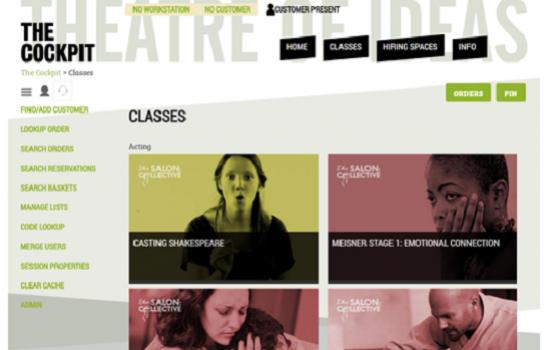Online and mobile ticketing is the new normal. But the frustrations of ticket buyers – and box office staff – must be taken seriously if it is to be done well, says Ben Curthoys.

For online ticket buyers there’s nothing more irritating than having to phone the box office. They only have to do this when the website doesn’t work for them – maybe the discount they’re entitled to isn’t available online, or the seating plan didn’t work on their mobile device, or they couldn’t find anything that suited them, or the whole website was just so difficult to navigate that they couldn’t stand it a moment longer.
For box office staff, this also presents a problem. The customers they are most likely to be speaking to on the phone are the ones who are annoyed at having wasted their time trying – and failing – to book tickets online. It’s not a great start to a sales conversation.
But if a seamless online user experience for everyone is the goal, then the problem – given the complexities of membership pre-sales, ticket allocations, discounts, packages, group bookings, etc. – is how to achieve it.
Everyone benefits from reducing the number of clicks it takes to buy a ticket
At Monad, we think we’ve found a solution. Built into the system from the ground up is that web sales come first. Our box office staff use the same website for selling tickets that online customers use for buying them. Staff members get more options than the public when they login. For example, they can access different payment types or delivery methods, or can have different themes optimised for point-of-sale touch screens. But underneath it’s still the same system that the public uses.
What this means is that box office staff, who use the system more than anyone, are at the forefront of our online ticketing development. They can’t ignore online booking challenges by saying “we’ll just do that manually; they’ll have to phone in”. Online ticketing has to work – and work well – for them.
This means the public get the best possible user experience, because box office staff are on the website all day every day, using it to sell tickets. Any irritating extra clicks, confusing navigation and unnecessary checkout steps get noticed and flagged up immediately. And when they’re fixed, they’re not just fixed for the staff, they’re fixed for everyone.
Take the text and date search functions, for example. If the box office team finds that a search returns unexpected results, or a common search doesn’t find a show, we hear about it. We can work out why and can tweak the algorithms before baffled online customers start leaving the site without having found what they were looking for.
For the organisation, customer service is improved at the same time as relieving pressures on the box office. The ticket-buying process is sped up; fewer frustrated phone calls means less staff time spent dealing with problems. Staff are more familiar with the website so better able to help when people do call, and training is quicker because the system is so easy to use that even the public can manage it. Everyone wins.
No online customer should ever have to give up and phone the box office – or worse still, give up and not phone the box office – so the subtle details of the Monad system have been designed to mirror a ticket-buyer’s thought processes. We’ve put ourselves in our customers’ shoes to design a system that responds to the way they think, not the way that software developers think they ought to think.
Let’s look at a few examples:
Choose your seats
After choosing a performance and a date, I bet your next thoughts are “I need x seats” and “we want to sit together”. So, we start with the question: “How many seats would you like?” Then with a single click you can move all the selected seats – at the selected discounts – around the seating plan.
The group of seats is offered as close together as availability will allow, even if that means breaking across rows or aisles for large orders or nearly sold out shows. This usability is a real joy for the increasingly popular option of mobile devices, where tapping seats individually is especially annoying.
Go mobile
The work we’ve put into improving the mobile experience for customers, supporting gestures and swipe and pinch to navigate the plan, feeds back into the staff interface.
Mobile phones and tablets aren’t the only touch interfaces, point-of-sale terminals with touch screens and self-service kiosks also benefit. It’s even possible for front of house staff to carry a tablet and have full access to the ticketing system whilst helping customers, from looking up accounts and order histories to selling tickets and memberships.
Eliminate pointless questions
Everyone benefits from reducing the number of clicks it takes to buy a ticket, not least a staff member dealing with a queue of door sales. The same is true for all aspects of the checkout flow, from creating an account, filling in contact details, making gift aid declarations, all the way to finally answering the marketing permission questions. Any time there’s a step we can skip, we do – if we already hold the information needed to complete a step, that step will be taken automatically with no user intervention needed.
Respond to the buyer
A person buying tickets to the panto is probably interested in only buying tickets to one performance of that one show. It’s worth trying to upsell them more tickets to that show, but given the diversity of panto audiences, presenting them with a list of other shows that other panto-bookers have bought may divert them in random and inappropriate directions.
On the other hand, festival-bookers are likely to be interested in several events. If, having selected an event, they are pushed into the check-out basket and moved along towards the exit, we’re going to miss out on being able to show and sell them the whole programme. So, for a festival we can make a running basket visible as we go along. Adding tickets to it won’t take you off to the basket page, but leaves you where you are to scroll down and keep adding more tickets.
A better user experience for both ticket buyers and box office staff means both higher revenues and lower costs for the organisation. Online and mobile ticketing is the new normal. It’s no longer enough that it is done at all: it is vital that it is done well.
Ben Curthoys is founder and Chief Executive of Monad Ticketing.
www.monadticketing.com
E: bencurthoys@monadticketing.com
T: 020 3239 3782
This article, part of the Making the Most of the Box Office feature, is sponsored by Monad Ticketing.
Monad Ticketing is currently recruiting for a Support Engineer to join the company. Full details available on ArtsProfessional.





